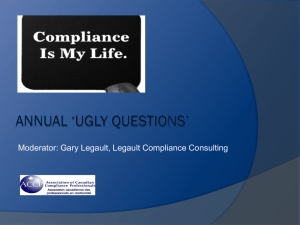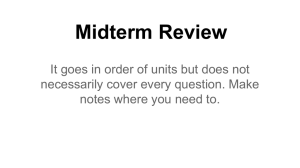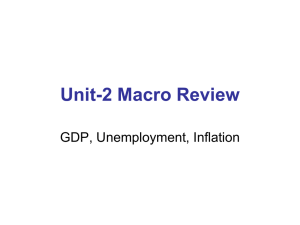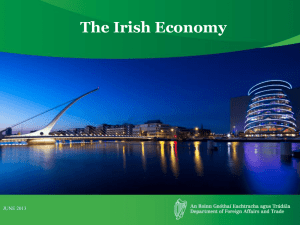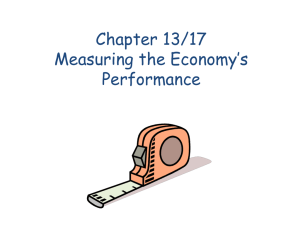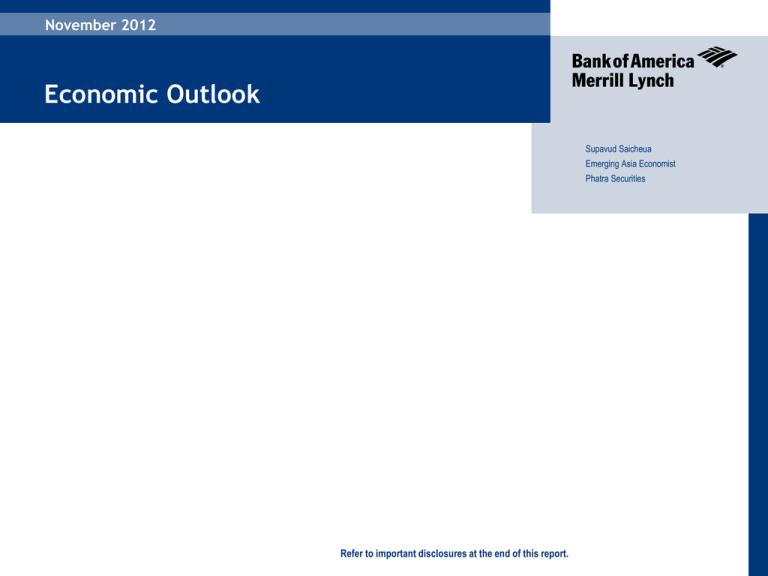
November 2012
April 2012
Economic Outlook
Supavud Saicheua
Emerging Asia Economist
Phatra Securities
Refer to important disclosures at the end of this report.
1
2013 risks remain on downside
April 2012
Recent data in US and China raise hope for
improving economic situation
US: improving housing sector, employment
China: pick up signs of IP, retail sale, exports
Global growth has slowed and risks remain
on the downside.
Europe is in a prolonged recession
Global
US
Euro
Japan
China
EM
GDP growth for major countries
Actual BoAML
BoAML Consensus
2011
2012F
2013F
2013F
3.8
3.1
3.2
na.
1.8
2.1
1.5
2
1.5
-0.6
-0.4
0.3
-0.8
2.3
1.2
1.2
9.3
7.7
8.1
8.1
6.2
5
5.4
na.
Source: BoAML
US faces risk of fiscal drag of as much as 4.6%
of GDP by end 2012.
Fiscal stimulus: constrained in advanced
economies. China and EMs has room to ease
Central banks will ease further. More QEs in
advanced economies
“2013: Low growth with high liquidity and still volatility”
Refer to important disclosures at the end of this report.
2
April 2012
US Fiscal cliff
The prospect of split govt post election means significant downside growth concerns
from the fiscal cliff remain.
The negotiation process to be messy and the ultimate solution is likely a few weeks
away.
Refer to important disclosures at the end of this report.
3
April 2012
Fed QE3+4
The slow recovery in the labor market is likely
to lead the Fed to extend QE3 into 2014 at
least and hold policy rates near zero through
late 2015.
The Fed will likely announce a new Treasury
QE program at the Dec. $45bn Treasury buying
to replace expiring Twist, means ($40bn +
$45bn) x 12 months = $1020 bn/year
In 2008, Fed balance sheet was $870bn. Now it
is $2.8trn. If QE3 goes as expected, balance
sheet will expand to $5.5trn by mid 2015.
Some doubt effectiveness of QE3 in reviving
the real economy. However, QE3 is meant to
“buy time” and be the antidote to the risk of
fiscal cliff.
More likely, QE3 would boost commodity
prices, EM inflation, and capital flows into EMs.
Refer to important disclosures at the end of this report.
4
April 2012
US corporate: high cash but not investing
Corporate investment was weak
Corporate has high cash balance
Source: Census Bureau, BofA Merrill Lynch Global Research
Refer to important disclosures at the end of this report.
5
US: fiscal outlook is grim
April 2012
Spending components (% of GDP)
Govt revenue and spending (% of GDP)
Medicare
Total noninterest spending
Social security
Medicaid
Revenue
Source: CBO, BoAML
Deficit projected in CBO’s baseline and scenario
(% of GDP)
Source: CBO, BoAML
Gross federal debt to GDP
Source: CBO, BoAML
Refer to important disclosures at the end of this report.
6
April 2012
Europe: Key points
OMT: buys time but is no end game
Provides a backstop to sovereign risk, but is not an end-game solution
Conditionality implies volatility
Reluctance from Germany and Spain to use the instrument
End game: from banking union to budgetary union, little progress leaves room for uncertainty
No appetite for budgetary union before 2014
Limited appetite for banking union: debate focuses on EU27 vs EMU 17 and scope of banks (all vs
large systemic only), the process will be slow
Still no debate and convergence on next permanent step for the EZ; no solution for Greece
Economic outlook penalised by uncertainties – zero growth
Ongoing fiscal adjustment and bank deleveraging: negative for internal demand
No permanent solution to EZ construction flows: deters investment
Exports: firms need to build up capacity
Refer to important disclosures at the end of this report.
7
April 2012
ESFS/ESM support
Refer to important disclosures at the end of this report.
8
Euro zone: Competitiveness and
structural problems
April 2012
400
Eurozone: Current account ($ bn)
300
Current account deficit to GDP
Avg 1991-1999
Avg 2000-2011
2001
2002
2003
2004
2005
2006
2007
2008
2009
2010
2011
200
100
-100
-200
-300
-400
Spain
-1.6
-5.9
-3.9
-3.3
-3.5
-5.3
-7.4
-9.0
-10.0
-9.6
-5.2
-4.6
-3.7
Portugal
-3.2
-9.5
-10.3
-8.2
-6.4
-8.3
-10.3
-10.7
-10.1
-12.6
-10.9
-10.0
-6.4
Greece
-2.4
-9.5
-7.2
-6.5
-6.6
-5.9
-7.4
-11.2
-14.4
-14.7
-11.0
-10.0
-9.7
Italy
0.9
-1.5
0.3
-0.4
-0.8
-0.3
-0.8
-1.5
-1.2
-2.9
-2.1
-3.5
-3.2
Ireland Germany
2.1
-1.0
-2.1
4.7
-0.6
0.0
-1.0
2.0
0.0
1.9
-0.6
4.7
-3.5
5.1
-3.5
6.3
-5.3
7.5
-5.7
6.2
-2.9
5.9
0.5
6.1
0.1
5.7
Source: IMF
France
1.2
-0.5
1.8
1.2
0.7
0.5
-0.5
-0.6
-1.0
-1.7
-1.5
-1.7
-2.2
Source: IMF
Unit labor cost
Government deficit 2012 (% of GDP)
Source: IMF, BIS
Source: The economist poll, EIU
Refer to important disclosures at the end of this report.
9
April 2012
China: leadership change
“If we fail to handle this issue well, it could prove fatal to the Party and even
cause the collapse of the Party and the fall of the State”
Hu Jintao, President of China speaking that the 18th Communist Party Congress
on the issue of corruption, 9 November 2012
Xi Jinping who will replace Hu as President in March 2013 will inherit a
recovering Chinese economy (2013 GDP growth estimate 8.1%) but will have
to sustain this growth while introducing reforms that combat corruption.
China has become more assertive about its claims in the South China Sea
which stir nationalist sentiment that shore up support for the government.
However, other countries in the region – Japan, Australia, Korea and some
ASEAN countries – have become nervous. US is taking advantage of the
situation with Pres Obama visiting Myanmar and joining the ASEAN Summit.
Good news on Oct export growth of 11.6% (while import grew 2.4%) show that
China is reliant on exports. But China needs to rely more on private
enterprise and consumer spending which means curbing the power of SOEs
and land grab by corrupt local officials.
Refer to important disclosures at the end of this report.
10
April 2012
Rising supply and wage cost
Refer to important disclosures at the end of this report.
11
April 2012
Manufacturers under pressure esp mid-up
stream cos
Refer to important disclosures at the end of this report.
12
April 2012
Exposure to property is significant & rising
Source: CEIC, BoAML
Refer to important disclosures at the end of this report.
13
April 2012
Thailand: GDP Growth
Avg real GDP growth (2000-10) = 4.4%
GDP Per cap as of 2011=$5,395/year
Refer to important disclosures at the end of this report.
14
April 2012
GDP by sector
Refer to important disclosures at the end of this report.
15
GDP by expenditure
April 2012
Share (%)-2011
Growth (%yoy)
Refer to important disclosures at the end of this report.
16
April 2012
Investment
Refer to important disclosures at the end of this report.
17
April 2012
Exports
Refer to important disclosures at the end of this report.
18
April 2012
Exports
Refer to important disclosures at the end of this report.
19
April 2012
Government
Refer to important disclosures at the end of this report.
20
April 2012
External debt
Refer to important disclosures at the end of this report.
21
April 2012
International reserve
Refer to important disclosures at the end of this report.
22
April 2012
Employment
Refer to important disclosures at the end of this report.
23
April 2012
Production: nearly back to pre-flood
Automobile production back to normal earlier than expected
Recovery in electronic and electrical appliances lagging
Labor-intensive sector was weak, affected by wage increases. Relocation to neighboring countries
was evident.
Manufacturing production index
Source: OIE
Manufacturing production index by sector
1Q-11 2Q-11 3Q-11 4Q-11 1Q-12 2Q-12
Beverages
164
144
146
150
177
156
Textiles
72
63
60
47
51
51
Apparel
133
120
118
100
111
108
Paper
122
119
122
105
120
118
Refined petroleum
127
141
144
131
156
147
Chemicals
157
162
170
153
170
170
Rubber and plastic products
132
128
146
118
133
133
Non-metalic mineral
169
164
171
149
180
180
Basic metals
139
124
130
110
133
122
Machinery and equipment
240
239
221
123
219
269
Jewelry
51
42
60
59
51
41
Computing machinery
758
825
887
374
606
648
Intergrated Circuits
170
172
161
65
107
115
Electrical appliances
121
116
111
48
74
78
Vehicles
379
273
400
140
409
486
Total
188
182
195
125
175
179
Refer to important disclosures at the end of this report.
24
April 2012
Domestic recovery
Strong pent-up demand for durable goods
Source: Toyota
General consumption pick up as well
Source: BoT
Capital investment: replacement from flood damage
Source: BoT
Refer to important disclosures at the end of this report.
25
April 2012
Investment and releveraging
Direct investment
Strong retail lending
25%
20%
15%
10%
5%
0%
-5%
-10%
-15%
-20%
Corporate
Source: BoT
Jul-11
Jul-09
Jul-07
Jul-05
Jul-03
Jul-01
-25%
Retail
Source: BoT
Refer to important disclosures at the end of this report.
26
April 2012
Exports underperform
Export growth: agriculture exports fell nearly 40%yoy
Thailand exports’ market
Share (% of total)
% growth
Japan
US
EU (15)
Asean (5)
Indochina
China
Middle east
Australia
Total
Source: BoT
Source: BoT
Rice export: sharp fall in quantity
1H12-%YoY
-4.1
3.4
-12.3
5.8
14.1
7.5
8.2
4.3
-2.0
Top 6 exports to Europe (% of total exports)
Automatic data processing
machines and parts thereof
Precious stones and jewellery
Prepared poultry
Rubber products
Apparel and clothing
Motor cars, parts
9.4
8.2
4.4
4.2
4.1
3.8
Top 6 exports to China (% of total exports)
Rubber
Source: BoT
Automatic data processing
machines
Chemical products
Polymers of ethylene, propylene,
etc
Rubber products
Tapioca products
Refer to important disclosures at the end of this report.
18.6
15.7
9.8
8.9
6.5
5.0
Source: MoC
27
Govt.: spending delay, policy costs
April 2012
Fiscal balance (Bt bn)
Bt bn
Revenue
Expenditure
Current FY
Fixed
Investment
Carry over
Budgetary balance
Non-budgetary balance
Cash balance before borrowing
Source: MoF
10M FY12
1,568
1,908
1,778
1,574
204
131
(340)
(36)
(377)
10M FY11
1,490
1,841
1,740
1,532
209
111
(351)
52
(298)
Government spending is slower than expected.
In first 10MFY12, govt disbursement was 74.7% of
total budget.
46% of investment budget spent so far
Downside risk on tax revenue from tax cut and tax
refund (Table below).
Rice pledging program is contingent liability. Loss to
govt. could be Bt70-100bn this year.
Cost of main policy (Bt bn/per year)
Loss in tax revenue
Energy subsidy
Corporate tax cut
First car buying program
Contingent liability
Rice pledging program
108
100
30
260
Source: Government, Phatra Securities
Refer to important disclosures at the end of this report.
28
FY13 budget, Public debt
April 2012
Government annual budget plan (Bt bn)
FY 2012
Revenue (Net)
1,980
Expenditures
2,380
Budget balance
-400
% of GDP
-3.4
Expenditures
Current expenditures
1,841
Repay treasury reserve
53,918
Capital expenditures
439
Principal repayment
47
FY 2013
2,100
2,400
-300
-2.6
% chg
6.1
0.8
-25.0
1,902
449
49
3.3
Budget deficit is set at 2.6%of GDP, less than FY12.
Adding flood prevention spending, net stimulus to
be 3.5% of GDP (assuming half is spent in FY13).
2.4
4.9
Source: Budget bureau
Public debt outstanding
Public debt on the rise from government populist
policy and infrastructure plan.
As of Jun, public debt rose 12% from Dec last year
to Bt4,791bn.
Source: PDMO
Refer to important disclosures at the end of this report.
29
April 2012
Thailand flood prevention plan
Thailand long-term infrastructure plan
Govt wants to drive growth
Bt350bn emergency decree for flood prevention
investment has not been spent. So far, Bt40bn
approved.
Bt350bn must be committed by June 2013.
Govt. set to hire consortium to draw up conceptual
plan which should be approved by early next year.
Then spending could begin.
For longer term, Bt2.3trn govt. investment plan is
meant to “transform Thailand” with broad-based
infrastructure building.
Govt wants BoT help to release liquidity and cut
financing costs.
Govt expediting four high-speed train lines
centered in Bangkok to start in early 2013
The high-speed trains cover 3,100 kms, costing
Bt980bn. First phase Bt480bn.
Refer to important disclosures at the end of this report.
30
April 2012
Inflation is under control
Source: MoC
Inflation expectation is higher than policy rate
Inflationary pressure declines…but risk from
oil prices
Cost pressure declines
Source: MoC
Inflation is driven more by fuel prices
CPI vs Food prices
CPI vs Fuel prices
Correlation for the period
Weight in CPI
2003-2012
2003-2012
33.0%
0.35
0.35
5.3%
0.78
0.79
Source: Phatra Securities calculations
Source: BoT
Refer to important disclosures at the end of this report.
31
April 2012
Real deposit rate is near zero
Monetary policy: room for easing
Output gap is nearly closed
1Q08
Source: MoC, Reuters
Policy rate and inflation
1Q09
1Q10
1Q11
1Q12
1Q13
1Q14
Source: BoT (inflation report Aug 12)
Foreign holdings of Thai bonds
Fgn Hold in Govt. Bonds (Bt bn)
Source: MoC, BoT
Jul-12
Jan-12
Jul-11
Jan-11
Jul-10
Jan-10
Jul-09
Jan-09
Jul-08
Jan-08
Jul-07
Jan-07
700
600
500
400
300
200
100
-
Fgn Hold in BoT Bonds (Bt bn)
Source: Thaibma
Refer to important disclosures at the end of this report.
32
April 2012
The optimistic scenario
Opening-up of Myanmar holds great potential for the “ASEAN mainland”
For Dawei to happen, needs not just Myanmar-Thai MOU but full participation from Japan.
Govt. spending on infrastructure would complement the ASEAN mainland boom
Top-line growth would be boosted so that costly populist policies can be absorbed
However, sustainable growth may need genuine reforms: better education and training;
reduced corruption; less distortion of the free market
Refer to important disclosures at the end of this report.
33
April 2012
Refer to important disclosures at the end of this report.
Source: ADB
34
Thailand: Economic Forecast
April 2012
% Growth, YoY
GDP
Private consumption
Government consumption
Total investment
Private investment
Government investment
Exports (BoP basis-$ term)
Imports (BoP basis-$ term)
Current account – US$ bn
Current account-% of GDP
Inflation
2011A
0.1
1.3
1.4
3.3
7.2
-8.7
14.3
24.9
5.9
1.7
3.8
Phatra
2012F
2013F
5.3
4.5
4.8
4.0
3.5
3.0
11.3
11.0
12.5
10.0
7.0
15.0
3.0
11.0
8.0
10.0
-1.6
0.3
-0.4
0.1
3.1
3.2
Consensus
2012F
2013F
5.3
4.4
4.7
4.0
n.a.
n.a.
12.6
6.7
n.a.
n.a.
n.a.
n.a.
7.5
10.6
11.7
9.1
1.4
5.1
n.a.
n.a.
3.0
3.3
BoT
2012F
5.7
5.8
3.0
n.a.
12.4
6.3
4.4
7.0
3.7
n.a.
3.0
2013F
4.6
3.8
2.5
n.a.
6.8
21.7
9.0
9.3
2.3
n.a.
2.8
MoF
2012F
2013F
5.5
5.2
5.2
4.0
3.0
3.2
12.8
11.4
14.1
10.0
8.1
16.9
4.5
10.5
10.5
11.0
-2.0
-2.1
-0.5
-0.5
3.3
3.5
NESDB
2012F
2013F
5.5-6.0
n.a.
4.8
n.a.
3.8
n.a.
11.3
n.a.
12.2
n.a.
8.1
n.a.
7.3
n.a.
13.5
n.a.
0.3
n.a.
0.1
n.a.
2.9-3.4
n.a.
Source: NESDB, BoT, MoF, Consensus, Phatra Securities (as of Oct.12)
Refer to important disclosures at the end of this report.
35
April 2012
Thailand background (1)
Political and Regulatory regime: Generally benign neglect
Government generally refrain from intervention and it is written in the current constitution that the
government should promote free markets and is not allowed to compete with the private sector
except for national security reasons and the provision of public goods.
Minimum wage has become a populist tool to win votes. The government will raise minimum wage
by 40%, applying it throughout the Kingdom starting 1 Jan 2013. Other populist policies include
price support for rice, debt relief for farmers, easy credit for villagers, and universal health and
free education.
Banks and insurance are regulated with limited room for foreign participation. Other domestic
industries also provide limited access to foreigners such as retail trade and telecoms. Foreign
participation is welcomed for export industries such as automobiles.
Refer to important disclosures at the end of this report.
36
April 2012
Thailand background(2)
Economic regime: an open economy
Thailand is a middle income country with per capita income of about $5500. Exports of goods and
services account for 70% of GDP. Public debt is low at 43% of GDP but rising as the budget deficit is
expected to average about 3-4% per year given ambitious infrastructure investment plans estimated
to cost about Bt2.2trn ($70bn) over the next 5-7 years.
Good record of fiscal and monetary discipline. Since inflation targeting monetary policy regime was
adopted in 2000, inflation averaged 2% per year. There is legislation to explicitly protect Bank of
Thailand’s independence and core inflation ceiling set at 3% has been endorsed by the government.
Government revenue amounts to about 18-18% of GDP.
Private consumption has averaged a steady 55-57% of GDP while private investment about 20% of
GDP. Income and wealth distribution is uneven. Agricultural output is 10% of GDP but employs about
40% of the labor force while manufacturing is 40% of GDP but employs 15% of the labor force.
Refer to important disclosures at the end of this report.
37
April 2012
Thailand background(3)
Socio-Demographic
Birth rates peaked in 1974 and has since declined to 1.3% at present. It is estimated that Thailand’s
labour force will trough around 2015 after which Thailand’s dependency ratio will rise steadily.
Social welfare and pension system is not comprehensive, having been started in the 90s. There is a
pension scheme for the 2 million civil servants and private pension schemes exist for most of the
industrial workforce and other modern sectors (banking, state enterprises). However, no such
facilities exist for the farming sector and informal services sector accounting for 2/3 of the labor
force.
Universal health care was introduced in 2001. Costs have been rising especially for civil servants and
the government is working to contain the rising costs.
Refer to important disclosures at the end of this report.
38
April 2012
Thailand background(4)
Technology and media
Mass media is largely free, particularly printed media. Internet restrictions have been few except
for recent crackdown related to les majeste offences. Expansion of mobile phones had been
constrained by the politicization of the sector. Thailand is expected to grant 3G licenses to 3
operators by the end of 2012 after many years of delay.
Radio and television had been largely under the control of the government and the armed forces
because historically it was thought to be critical for national security. The army still controls many
free TV stations and all major radio stations. Cable TV and the emergence of community radio
stations have further dilute the government’s hold on this media.
Spending on R&D has been marginal, estimated at less than 0.24% of GDP. Thailand has few well
known brands. Only Jim Thomson Silk and Red Bull readily come to mind.
Refer to important disclosures at the end of this report.
39
Thailand statistical highlights (1)
April 2012
Population
Population: 67,091,089 (July 2012est.), country comparison to the world: 20
Age structure:
0-14 years: 19.5% (male 6,697,165/ female 6,386,840)
15-64 years: 71% (male 23,575,773/female 24,071,836)
65 years and over: 95% (male 2,870,445/female 3,489,030) (2012est)
Median age:
total: 34.7 years
male: 33.7 years
female: 35.6 years (2012est.)
Population growth rate: 0.543% (2012est.), country comparison to the world: 148
Birth rate: 12.81 births/1,000 population (2012est.), country comparison to the world: 154
Death rate: 7.38 deaths/1,000 population (July 2012est.), country comparison to the world: 119
Urbanization: 34% of total population (2010)
Rate of urbanization: 1.8% annual rate of change ( 2010-15 est.)
Source: The World Factbook, IMF, NSO
Refer to important disclosures at the end of this report.
40
April 2012
Thailand statistical highlights (2)
Population
Maternal mortality rate: 48 deaths/100,000 live births (2010), country comparison to the world: 110
Infant mortality rate: 15.9 deaths/1,000 live births, country comparison to the world: 108
Life expectancy at birth: 73.8 years (male: 71.4, female: 76.3), country comparison to the world: 114
Total fertility rate: 1.66 children born/woman (2012est.), country comparison to the world:174
Health expenditures: 3.88% of GDP (2010), country comparison to the world: 166
Doctors: 0.35 per 1,000 (2011)
Beds: 2.1 beds per 1,000 (2011)
Literacy: 92.6% of total population (definition: age 15 and over can read and write)
School life expectancy (primary to tertiary education): 12 years
Unemployment, youth ages 15-24: 4.3%, country comparison to the world: 125
Source: The World Factbook, IMF, NSO
Refer to important disclosures at the end of this report.
41
April 2012
Thailand statistical highlights (3)
GDP
Fiscal
At purchasing power parity (PPP): $602.2bn(2011)
At market exchange rate: $345.6bn (2011)
Budget: revenues: $62.85bnn (FY12 target) or 17.2% of
GDP)
Real GDP growth rate:
5.4% (2012, Consensus forecast)
0.1% (2011)
7.8% (2010)
-2.3% (2009)
expenditures: $75.5bn (FY12 target)
Budget balance: -3.5% of GDP (FY12 est.)
Public debt: 43.3% of GDP (Jun.12)
Inflation and interest rate
Per capita (PPP): $9,398 (2011)
Per capita (Market rate): $5,395 (2011
GDP - composition by sector:
agriculture: 13.3%, industry: 34%, services: 52.7% (2011)
Labor
Consumer prices index: 3.38% (Sep.12), average (20052011) = 3.3%
Central bank policy rate: 2.75% (Oct.12), average (20052011) = 3.07%
Commercial bank prime lending rate (avg 4 largest banks):
7.126% (Oct.12)
Commercial bank 12months deposit rate (avg 4 largest
banks): 2.856% (Oct.12)
Labor force: 40.09 million (July 12)
Labor force - by occupation:
agriculture: 40.7%, industry: 13.2%, services: 46.1% (2011 est.)
Unemployment rate: 0.56% (July 12)
Exchange rate: Bt/US$1
Population below poverty line: 8.1% (2009 est.)
Avg over the period
End of period
2007
2008
2009
2010
2011
33.68
34.54
34.71
33.33
33.34
34.3
30.01
31.68
31.52
30.46
Jan-Sep
2012
30.81
31.19
Source: The World Factbook, IMF, NSO
Refer to important disclosures at the end of this report.
42
April 2012
Important Disclosures
Copyright 2012 Phatra Securities Public Company Limited (“Phatra Securities”). All rights reserved. Any unauthorized use or disclosure is prohibited. For
distribution outside of Thailand, the distribution will be restricted to only “institutional investors” or other similar types of investors as stipulated in each
jurisdiction. In preparation of this research report, Phatra Securities has assumed and relied on the accuracy and completeness of all information or data
supplied or otherwise made available to us including public available information. Phatra Securities assumes no responsibility for independent
investigation or verification of such information and have relied on such information being complete and accurate in all material respect.
Neither the information nor any opinion expressed constitutes an offer, or an invitation to make an offer, to buy or sell any securities or any options,
futures or other derivatives related to such securities ("related investments"). Officers of Phatra Securities may have a financial interest in securities of
the issuer(s) or in related investments. Phatra Securities or its affiliates may from time to time perform investment banking or other services for, or solicit
investment banking or other business from, any entity mentioned in this research report.
This research report is prepared for general circulation and is circulated for general information only. It does not have regard to the specific investment
objectives, financial situation and the particular needs of any specific person who may receive this research report. Phatra Securities assumes no
obligation to update or otherwise revise this research report. Investors should seek financial and investment advice regarding the appropriateness of
investing in any securities or investment strategies discussed or recommended in this research report and should understand that statements regarding
future prospects may not be realized. Investors should note that income from such securities, if any, may fluctuate and that each security's price or value
may rise or fall. Accordingly, investors may receive back less than originally invested. Past performance is not necessarily a guide to future performance.
Foreign currency rates of exchange may adversely affect the value, price or income of any security or related investment mentioned in this research
report. In addition, investors in securities such as ADRs, whose values are influenced by the currency of the underlying security, effectively assume
currency risk.
Refer to important disclosures at the end of this report.
43



